Posted on January 22, 2016 by Euan Mearns
Guest post by Matt Mushalik who runs the Australian Crude Oil Peak web site where The myth of US self-sufficiency in crude oil was first published. There is a wealth of information and brilliant charts below the fold.
Google for “US energy independence” and you will get 134k results, “US self sufficiency” yields 10k results. Here are some examples of what the media reports:
In Aljazeera’s Inside Story, 10/1/2016, titled “How much support will Saudi Arabia win against Iran?” the delicate relationship between the US, Saudi Arabia and Iran is discussed with 3 panellists. The moderator wanted answers in the context of “the US is almost at a tipping point, is almost energy independent..”
http://www.aljazeera.com/programmes/...170443000.html
https://www.youtube.com/watch?v=-xvjeUKpkP8 (18:45)
In the State of the Union Address 2014 Obama proudly announced: “Today, America is closer to energy independence than we’ve been in decades”. In the latest SOUA on 12th January 2016, we hear: “Meanwhile, we’ve cut our imports of foreign oil by nearly sixty percent”
On 16/1/2016, the 7pm news of Australia’s public broadcaster ABC TV had this snippet:
http://www.abc.net.au/news/2016-01-1...ction=business
Let’s look at the data:
Crude imports

Fig 1: US crude oil production, imports and exports
The graph shows that crude production reached almost 9.5 mb/d in 2015, just short of the historic peak in 1970. But imports are still 7 mb/d. Exports were only around 500 kb/d (to Canada) due to an export ban (which was recently lifted). Let’s zoom into the period since 2007, the peak year of imports.

Fig 2: US crude production vs imports since 2007
We have several phases in this crude oil import history:
3 year decline of imports due to recession as oil prices went up, followed by the financial crisis
A rebound when quantitative easing started
A 2 mb/d decline 1 year after the shale oil boom started
In 2013 the growing production curve intersects with the declining import curve at around 7.5 mb/d i.e. a production/import ratio 50:50. Since then production grew another 2 mb/d but has peaked in April 2015 because of low oil prices which hit the shale oil industry. Imports did not continue to decline but remained basically flat.
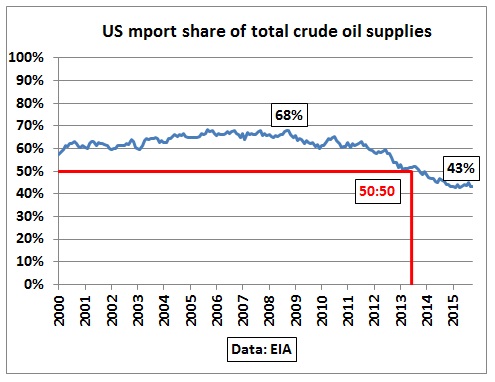
Fig 3: Import share of crude oil supplies (=production+imports)
Due to slightly declining crude production the ratio did not improve anymore in 2015 and appears to be stuck at 43%. Clearly, this is not “virtually self-sufficient in [crude] oil”.
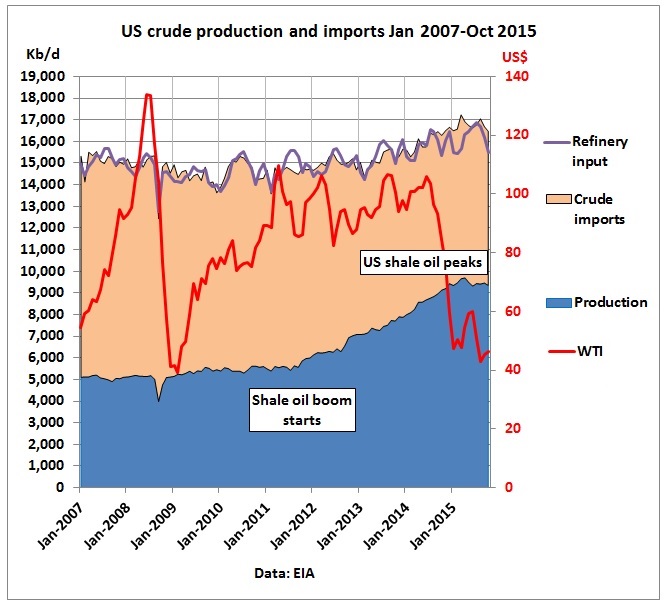
Fig 4: US crude production and importsFig 4: US crude production and imports
In the above graph we stack crude imports on top of production and compare it with refinery inputs. The cumulative difference is only 0.3%
Let’s have a look where the crude oil imports come from:
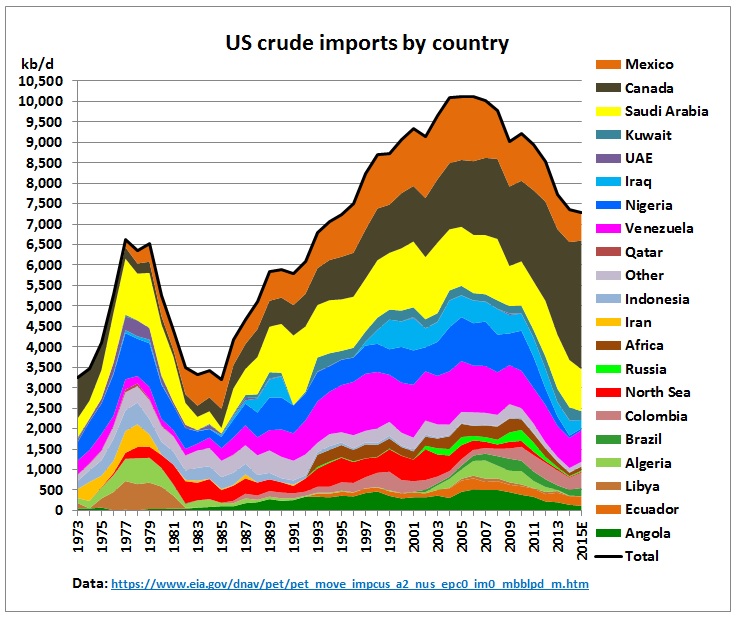
Fig 5: US crude imports by country
Data are from here:
https://www.eia.gov/dnav/pet/pet_mov...0_mbblpd_m.htm
Around half of the imports in 2015 were from the neighbouring countries Mexico and Canada. Imports from Mexico peaked in the same year in which Mexican oil production peaked:
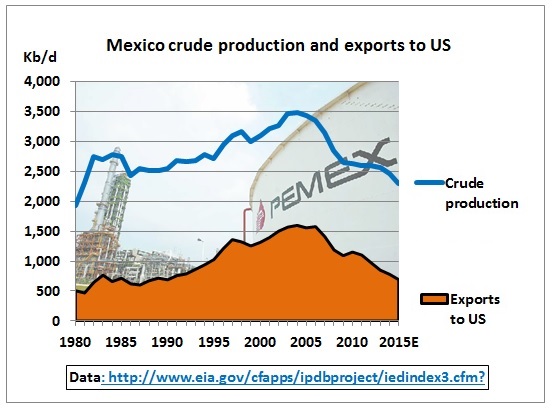
Fig 6: Mexican crude production and exports to US
The shape of the 2 curves is quite similar. Peak oil at work.
In contrast to Mexico, US imports from Canada increased:
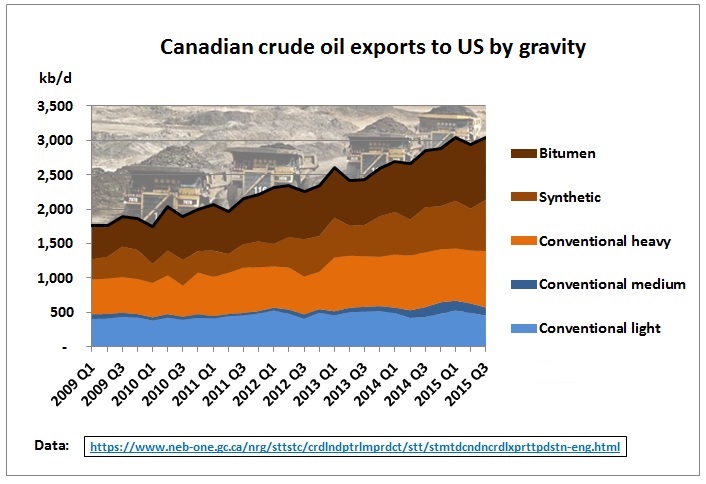
Fig 7: Canadian crude exports to the US
Exports of conventional crude (light and medium) was around 500 kb/d for the whole period. Heavy crude, synthetic crude and bitumen from tar sands doubled from 1.25 mb/d to 2.5 mb/d. That of course is not a good record as oil from tar sands produces 20% more CO2 emissions than conventional oil.
US imports/exports of products

Fig 8: US product imports by fuel
Increasing imports of unfinished oils, blending components and gasoline as well as a surge in fuel oil (which had decreased after the 2nd oil crisis) since around 2000 contributed to a peak in 2005/06. An import decline of NGLs, diesel, fuel oil and other liquids brought US product imports back to levels before the peak.

Fig 9: US product exports by fuel
Much of the increase in diesel and gasoline exports started 2005, before the shale oil boom – which began 6 years later in 2011. Because of shale oil being a very light oil the increase in exports after 2011 was mainly natural gas plants liquids.
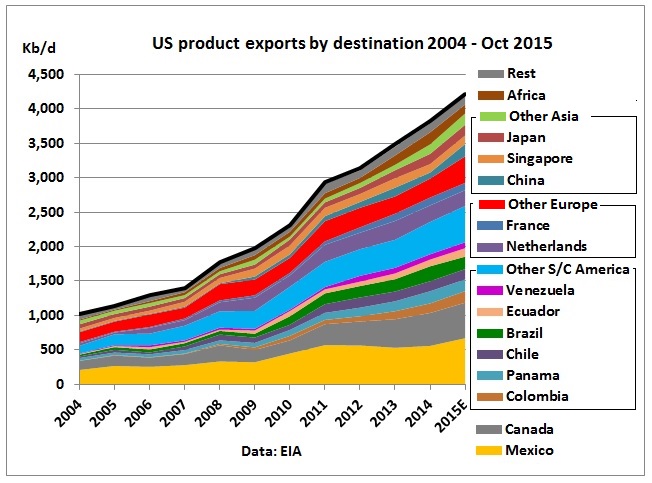
Fig 10: US product exports by country of destination
Most of the exports go to Mexico, Canada and other South/Central American countries.
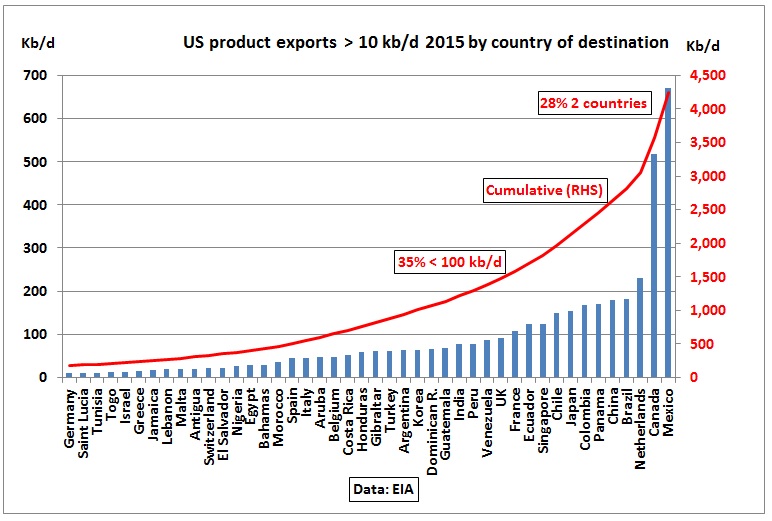
Fig 11 US product exports in 2015 (Oct last 12 months)
US product exports go to 100 different countries. However, for most of the countries, export volumes are rather small. 35% of export volumes are less than 100 kb/d (average 40 kb/d). Another 37 % are between 110 kb/d (France) and 240 kb/d (Netherlands). The share of US exports of all Netherlands imports of products is just 13%. It would require more detailed analysis whether such limited contributions would have any price setting role on global product markets.
US net product exports
As an example, we take diesel
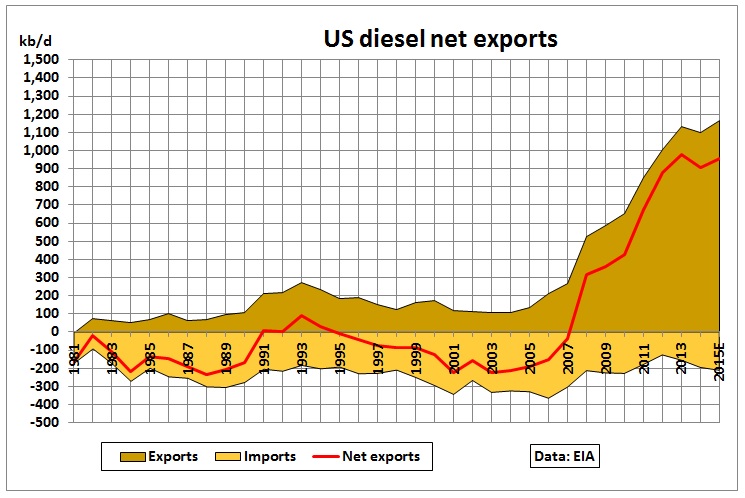
Fig 12: US diesel import-export balance
Diesel exports (around 80% of which is 15 ppm sulfur) started to surge when the US went into recession. The steep growth period seems to be over now.
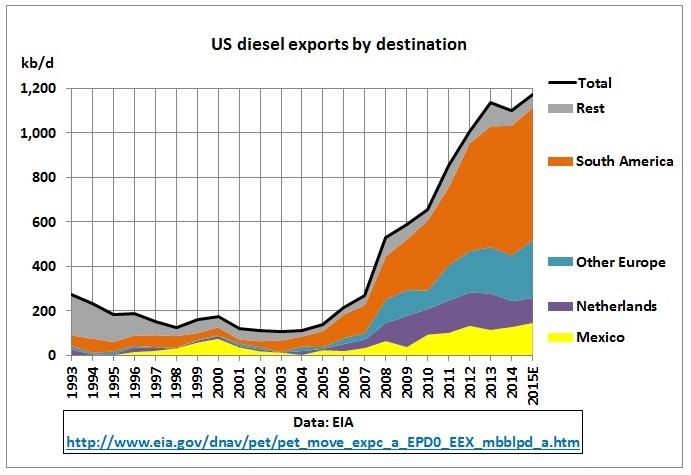
Fig 13: US diesel exports by destination
Data from here: http://www.eia.gov/dnav/pet/pet_move...X_mbblpd_a.htm
South and Central America received most of US’ diesel exports
US product trade balance
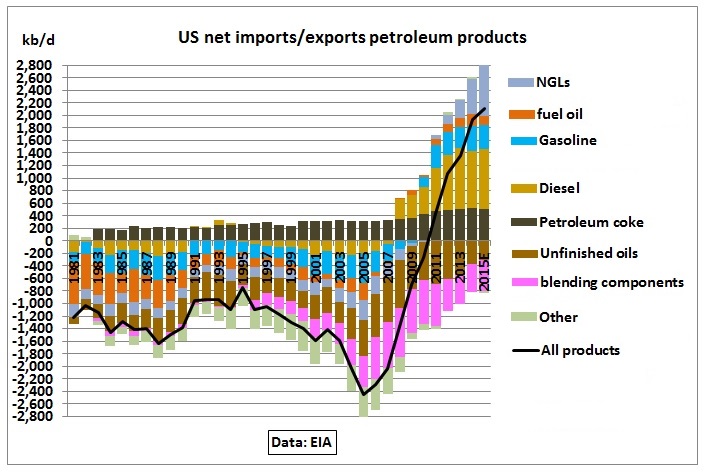
Fig 14: US product imports and exports
The US became net product exporter in 2011, growing to 2.1 mb/d of net product exports in 2015. However, imports and exports are totally different and cannot be swapped or offset against each other. Blending components for example are needed for the production of gasoline and are therefore a necessary refinery input. Thus, the product import dependency is still 800 kb/d
On the export side, petroleum coke is not a liquid, but the waste product from tar sands refining.
Fig 15: Petroleum coke (with its own environmental hazards)
http://www.nationofchange.org/after-...ago-1381932644
Of course, total product exports of 2.8 mb/d are dependent on crude imports at the ratio of 43%. (i.e. 1.2 mb/d). Therefore, the US product trade is dependent on 2 mb/d of imports (1.2 mb/d crude +0.8 mb/d products)
North American self sufficiency
Fig 5 shows that half of US crude imports come from Mexico and Canada. As US crude production growth has stalled, North America could only become self sufficient in crude oil by replacing the other half of crude imports i.e. increasing imports of liquids from Canadian tar sands by a theoretical 2.8 mb/d, assuming Mexico could continue to export 700 kb/d. If these exports were to shrink by the past rate of 100 kb/d pa, the additional tar sand import requirement would be 3.5 mb/d in 7 years provided US oil consumption would not change. This calculation is theoretical because refineries usually need a blend of different types of crudes, not just heavy oil from Canada. So there would be a minimum crude import requirement from outside North America. And Canada itself also imports around 300 kb/d from outside North America.
In any case, an increasing reliance on tar sands would be an environmental and climate disaster.
In May 2013, NASA climatologist James Hansen told the House of Commons’ Environmental Audit Committee on carbon budgets: “If we introduce the tar shale and tar sands as a source and exploit those resources to a significant extent, then the problem becomes unsolvable”
http://www.publications.parliament.u...60-i/c6001.htm
Saudi Arabia

Fig 16: Saudi liquids exports 2009 – November 2015
https://www.jodidata.org/oil/
What matters to global oil markets are exports. Saudi Arabia burns an additional 400 kb/d crude during summer months in power plants to produce electricity for increased air-conditioning. So if Saudi Arabia increases production in those months, the world markets won’t see a single drop of that oil.
According to JODI data, Fig 13 does not suggest that Saudi Arabia stepped up liquid exports in a significant way compared to the 3 previous years. Crude exports in 2015 were even 100-150 kb/d lower than in 2012 and 2013. This was offset by higher product exports of 400 kb/d, especially diesel.
Note also that Saudi crude exports in 2015 were only 50 kb/d higher than in 2006!
Outlook: shale oil peak
EIA’s latest short term outlook (Jan 2016)
Guest post by Matt Mushalik who runs the Australian Crude Oil Peak web site where The myth of US self-sufficiency in crude oil was first published. There is a wealth of information and brilliant charts below the fold.
Google for “US energy independence” and you will get 134k results, “US self sufficiency” yields 10k results. Here are some examples of what the media reports:
In Aljazeera’s Inside Story, 10/1/2016, titled “How much support will Saudi Arabia win against Iran?” the delicate relationship between the US, Saudi Arabia and Iran is discussed with 3 panellists. The moderator wanted answers in the context of “the US is almost at a tipping point, is almost energy independent..”
http://www.aljazeera.com/programmes/...170443000.html
https://www.youtube.com/watch?v=-xvjeUKpkP8 (18:45)
In the State of the Union Address 2014 Obama proudly announced: “Today, America is closer to energy independence than we’ve been in decades”. In the latest SOUA on 12th January 2016, we hear: “Meanwhile, we’ve cut our imports of foreign oil by nearly sixty percent”
On 16/1/2016, the 7pm news of Australia’s public broadcaster ABC TV had this snippet:
http://www.abc.net.au/news/2016-01-1...ction=business
Let’s look at the data:
Crude imports

Fig 1: US crude oil production, imports and exports
The graph shows that crude production reached almost 9.5 mb/d in 2015, just short of the historic peak in 1970. But imports are still 7 mb/d. Exports were only around 500 kb/d (to Canada) due to an export ban (which was recently lifted). Let’s zoom into the period since 2007, the peak year of imports.

Fig 2: US crude production vs imports since 2007
We have several phases in this crude oil import history:
3 year decline of imports due to recession as oil prices went up, followed by the financial crisis
A rebound when quantitative easing started
A 2 mb/d decline 1 year after the shale oil boom started
In 2013 the growing production curve intersects with the declining import curve at around 7.5 mb/d i.e. a production/import ratio 50:50. Since then production grew another 2 mb/d but has peaked in April 2015 because of low oil prices which hit the shale oil industry. Imports did not continue to decline but remained basically flat.

Fig 3: Import share of crude oil supplies (=production+imports)
Due to slightly declining crude production the ratio did not improve anymore in 2015 and appears to be stuck at 43%. Clearly, this is not “virtually self-sufficient in [crude] oil”.

Fig 4: US crude production and importsFig 4: US crude production and imports
In the above graph we stack crude imports on top of production and compare it with refinery inputs. The cumulative difference is only 0.3%
Let’s have a look where the crude oil imports come from:

Fig 5: US crude imports by country
Data are from here:
https://www.eia.gov/dnav/pet/pet_mov...0_mbblpd_m.htm
Around half of the imports in 2015 were from the neighbouring countries Mexico and Canada. Imports from Mexico peaked in the same year in which Mexican oil production peaked:

Fig 6: Mexican crude production and exports to US
The shape of the 2 curves is quite similar. Peak oil at work.
In contrast to Mexico, US imports from Canada increased:

Fig 7: Canadian crude exports to the US
Exports of conventional crude (light and medium) was around 500 kb/d for the whole period. Heavy crude, synthetic crude and bitumen from tar sands doubled from 1.25 mb/d to 2.5 mb/d. That of course is not a good record as oil from tar sands produces 20% more CO2 emissions than conventional oil.
US imports/exports of products

Fig 8: US product imports by fuel
Increasing imports of unfinished oils, blending components and gasoline as well as a surge in fuel oil (which had decreased after the 2nd oil crisis) since around 2000 contributed to a peak in 2005/06. An import decline of NGLs, diesel, fuel oil and other liquids brought US product imports back to levels before the peak.

Fig 9: US product exports by fuel
Much of the increase in diesel and gasoline exports started 2005, before the shale oil boom – which began 6 years later in 2011. Because of shale oil being a very light oil the increase in exports after 2011 was mainly natural gas plants liquids.

Fig 10: US product exports by country of destination
Most of the exports go to Mexico, Canada and other South/Central American countries.

Fig 11 US product exports in 2015 (Oct last 12 months)
US product exports go to 100 different countries. However, for most of the countries, export volumes are rather small. 35% of export volumes are less than 100 kb/d (average 40 kb/d). Another 37 % are between 110 kb/d (France) and 240 kb/d (Netherlands). The share of US exports of all Netherlands imports of products is just 13%. It would require more detailed analysis whether such limited contributions would have any price setting role on global product markets.
US net product exports
As an example, we take diesel

Fig 12: US diesel import-export balance
Diesel exports (around 80% of which is 15 ppm sulfur) started to surge when the US went into recession. The steep growth period seems to be over now.

Fig 13: US diesel exports by destination
Data from here: http://www.eia.gov/dnav/pet/pet_move...X_mbblpd_a.htm
South and Central America received most of US’ diesel exports
US product trade balance

Fig 14: US product imports and exports
The US became net product exporter in 2011, growing to 2.1 mb/d of net product exports in 2015. However, imports and exports are totally different and cannot be swapped or offset against each other. Blending components for example are needed for the production of gasoline and are therefore a necessary refinery input. Thus, the product import dependency is still 800 kb/d
On the export side, petroleum coke is not a liquid, but the waste product from tar sands refining.
Fig 15: Petroleum coke (with its own environmental hazards)
http://www.nationofchange.org/after-...ago-1381932644
Of course, total product exports of 2.8 mb/d are dependent on crude imports at the ratio of 43%. (i.e. 1.2 mb/d). Therefore, the US product trade is dependent on 2 mb/d of imports (1.2 mb/d crude +0.8 mb/d products)
North American self sufficiency
Fig 5 shows that half of US crude imports come from Mexico and Canada. As US crude production growth has stalled, North America could only become self sufficient in crude oil by replacing the other half of crude imports i.e. increasing imports of liquids from Canadian tar sands by a theoretical 2.8 mb/d, assuming Mexico could continue to export 700 kb/d. If these exports were to shrink by the past rate of 100 kb/d pa, the additional tar sand import requirement would be 3.5 mb/d in 7 years provided US oil consumption would not change. This calculation is theoretical because refineries usually need a blend of different types of crudes, not just heavy oil from Canada. So there would be a minimum crude import requirement from outside North America. And Canada itself also imports around 300 kb/d from outside North America.
In any case, an increasing reliance on tar sands would be an environmental and climate disaster.
In May 2013, NASA climatologist James Hansen told the House of Commons’ Environmental Audit Committee on carbon budgets: “If we introduce the tar shale and tar sands as a source and exploit those resources to a significant extent, then the problem becomes unsolvable”
http://www.publications.parliament.u...60-i/c6001.htm
Saudi Arabia

Fig 16: Saudi liquids exports 2009 – November 2015
https://www.jodidata.org/oil/
What matters to global oil markets are exports. Saudi Arabia burns an additional 400 kb/d crude during summer months in power plants to produce electricity for increased air-conditioning. So if Saudi Arabia increases production in those months, the world markets won’t see a single drop of that oil.
According to JODI data, Fig 13 does not suggest that Saudi Arabia stepped up liquid exports in a significant way compared to the 3 previous years. Crude exports in 2015 were even 100-150 kb/d lower than in 2012 and 2013. This was offset by higher product exports of 400 kb/d, especially diesel.
Note also that Saudi crude exports in 2015 were only 50 kb/d higher than in 2006!
Outlook: shale oil peak
EIA’s latest short term outlook (Jan 2016)

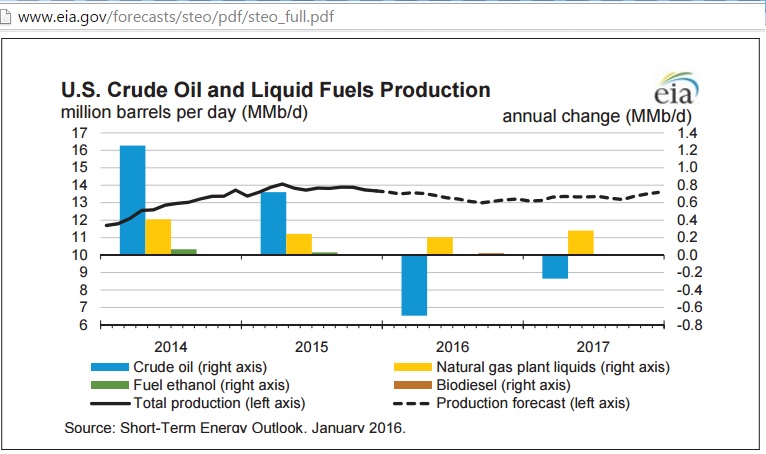
Commentaire